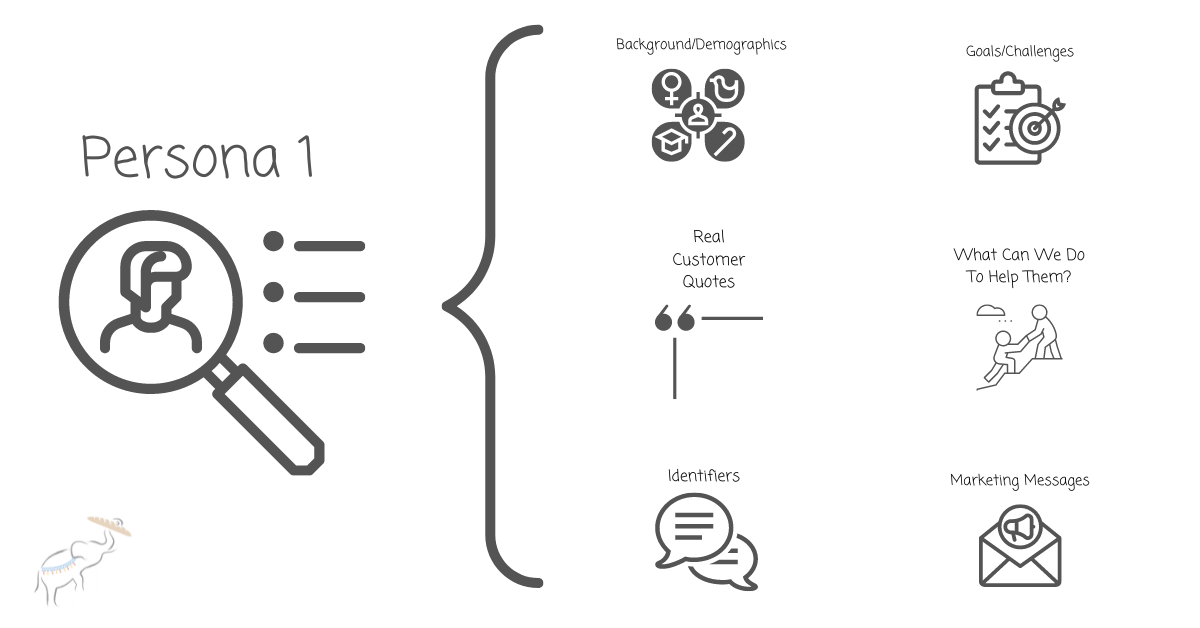Last Updated on June 12, 2023 by Bread and Circuses Team
What are Customer Personas?
Customer Personas–also known as Customer Personas or Customer Avatars– are fictional representations of your ideal customers based on market research and real data about your existing customers.
Personas are used to understand the needs, goals, motivations, behaviours, and pain points of your target audience, and they help businesses develop more effective marketing strategies that will resonate with different customer groups. They represent one of the best ways to know your customers.
Customer Personas are typically developed through a combination of quantitative and qualitative research, including surveys, interviews, and focus groups.
The goal is to create detailed profiles of your ideal customers, including demographic information like age, gender, income, and education and psychographic information like personality traits, values, and interests.
By creating detailed Customer Personas, businesses can better understand their target audience and tailor their marketing efforts to speak directly to their customers’ unique needs and preferences. This can help businesses create more effective marketing campaigns, improve customer engagement, and increase sales and revenue.
The concept of developing buyer/user personas has existed since the 1990s and early 2000s and was originally used for product design and user experience (UX) research, where designers used personas to represent different user types in order to design products that would meet the needs of those users.
Since then, personas have become a widely accepted tool in marketing and B2C or B2B content strategy, and are used by companies of all sizes to create more effective marketing campaigns and content that resonates with their target audience.
Today–many marketing professionals consider personas to be an essential part of their toolkit for understanding and engaging with customers
Why are Personas important for Content Strategy?
Creating Customer Personas is an incredibly important initial step towards building a cohesive content strategy for your organization.
Personas are important for content strategy because they help you understand your target customers in a deeper and more meaningful way–and, therefore–how you can reach them and address their needs at various stages of their customer journey. They help not only in tailoring your content to the specific needs and interests of your target audience so that your content is relevant and engaging– but also in helping understand where and how your customers consume information.
Customer Personas help you:
- Identify content gaps: Personas can help you identify areas where your target customers may be underserved or where there are gaps in the currently available content. For example, you may realize that your potential customers are inclined to do in-depth competitive research (searches for Product X vs Product Y) before making a purchase, so you would want to provide them with content that serves this behaviour.
- Prioritize content topics: Personas can help you prioritize the topics and types of content most likely to resonate with your target audience, allowing you to allocate your resources more effectively.
- Guide content creation: Personas can help guide the creation of specific pieces of content by providing a framework for understanding what your target audience needs and wants. E.g. you may realize that your target customers prefer visualizations more than in-depth written-word content.
- Tailor content distribution: Personas can help you tailor the distribution of your content to the specific channels and platforms your target audience is most likely to use. E.g. you may realize that your target customers use Instagram more than Tiktok and therefore create and distribute content for that platform.
How to Create Customer Personas For Content Marketing
Creating Customer Personas involves several steps that require research, data analysis, and creativity. Here are the general steps you can take to create personas for your marketing:
- Conduct market research: Start by gathering data on your target audience, including demographics, behaviour patterns, and preferences. This can be done through surveys, interviews, focus groups, social media analytics, or customer feedback.
- Identify common traits: Look for commonalities among the data you’ve collected to identify the traits that are most relevant to your business. This might include demographic information, such as age, gender, income, and education, as well as psychographic information, such as personality traits, values, and interests.
- Create detailed profiles: Use the data to create detailed personas that represent your ideal customers. Give each persona a made-up name, job title, and a backstory that includes their goals, challenges, and pain points.
- Use visuals: Create a visual representation of each persona, including a photo or illustration, to make the persona more relatable and memorable.
- Use the personas in your marketing: Once you’ve created your personas, use them to guide your marketing efforts. Tailor your messaging, tone, and content to appeal to the needs and preferences of each persona. This can help improve the effectiveness of your marketing campaigns and increase engagement with your target audience.
It’s important to note that personas should be based on data and research, not assumptions or stereotypes. Regularly updating your personas with new data and feedback can also help ensure that they accurately reflect your target audience.
Customer Personas Frequently Asked Questions
How long does it take to develop customer personas?
According to a survey by the Neilsen Norman Group, it can take one person in a smaller company between 3 and 9 days to create personas and a team of two between 1.5 to 5 days. In larger companies with increased complexity and stakeholders involved, it takes between 2 and 4 days for a team of four to develop personas.

